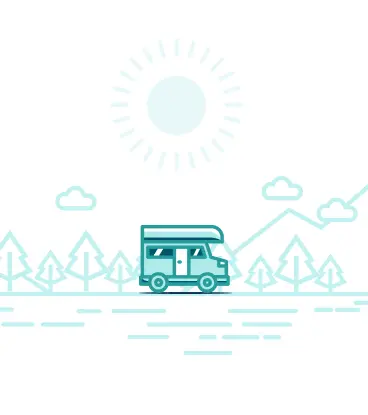
Best Time to Visit Olympic National Park

When to Visit Olympic National Park
Olympic National Park is a great place to visit any time of year! The coastal and lowland parts of the park tend to have a mild, temperate climate. They are open and accessible all year long.
The higher elevation parts are closed during the winter due to weather or road conditions. Deciding what time to visit depends on what you want to see and do. Each season has its perks.
Summer
July and August are the most popular times of year to visit Olympic National Park. That’s when most trails and roads are open. On Hurricane Ridge, summer wildflowers carpet the mountain meadows.
On a clear day, the views of the snowcapped peaks are spectacular! It’s also when temperatures are pleasant, ranging from mild to warm.
This makes it a perfect time to trek into the Olympic’s mountainous interior or plan a visit to the coast.
It can still rain during this time of year, so plan on bringing your lightweight raincoat just to be safe. The downside to visiting Olympic during the summer is the crowds.
Wait times at Hurricane Ridge and Hoh Entrance Stations can be especially long on summer weekends and holidays. Additionally, finding parking at the popular beaches and trailheads can be difficult.
The best way to beat the crowds is to arrive before 9 a.m. or after 5 p.m. Alternatively, check out the less-visited but just-as-beautiful sections of the park, like Lake Quinault.
Fall
The fall months are a lovely time to visit. With many families back in school, the park is less crowded. And while the weather definitely gets cooler, it’s still pretty mild at the beginning of fall.
October is one of the best months to try to see the salmon jump at the Salmon Cascades. It's also a great time to watch whales migrate down the coast. Towards the end of fall, some of the roads and trails may close due to weather.
 Shutterstock Image
Shutterstock Image
Winter
This is the best time to visit if you really want to avoid the crowds and enjoy some peace and solitude. It’s also when the peninsula gets most of its precipitation, both in rain and snowfall. So, dress for the weather if you venture out.
During the winter, the road to Sol Duc closes. The road to Hurricane Ridge is only open on the weekends and some holiday Mondays, weather and road conditions permitting.
You can still access the coast and many of the trails at Lake Crescent and Lake Quinault. And if you want to do a little winter storm watching at the coast, just remember to read and follow the beach safety guidelines and check current conditions.
Spring
Spring is another great time to visit. In fact, it’s the park’s second most popular season. Many of the roads and campgrounds start to reopen by April or May.
The weather is still a bit unpredictable at this time of year. Check the weather and trail conditions before venturing out.
Walking through the rainforest during this time of year is especially magical.
It’s also a great time to catch steelhead or cutthroat trout heading back upriver to spawn. Watch for whales migrating back up the Olympic Coast as well.
Whatever the Weather
 Shutterstock Image
Shutterstock Image
The weather within the park varies as you travel from the coast to the mountains. But no matter when you travel, it's a good idea to dress in layers, wear hiking shoes, and always pack a waterproof jacket.
And don’t forget to check the weather forecast before heading up to the hills or the tide chart before heading out to the coast.
It Isn’t Called Hurricane Ridge for Nothing
If you visit Hurricane Ridge on a clear day when the mountains are in view, count yourself lucky! About a mile above sea level in the sub-alpine region, these peaks are often shrouded in fog or hidden by overcast skies.
Hurricane Ridge has a short growing season. But what a season! Summer wildflowers blanket the ground. Olympic marmots wake up from their long winter slumber to eat and bask in the sunshine.
Summer is also one of the busiest seasons at the ridge with visitors flocking to the mountains to view the majestic peaks and hike in the meadows.
But it isn’t called Hurricane Ridge for nothing. During the winter, storms with hurricane-force winds pummel the ridge, giving this place its name. The hills can see up to 400 inches of snow a season!
When it isn’t storming, all that snow makes Hurricane Ridge a great winter playground.
The road to the ridge is open on winter weekends and holiday Mondays, weather and road conditions permitting. It’s a great time to enjoy snowshoeing, tubing, and skiing
The West Side or the Wet Side
The peninsula's west side, famous for its lush temperate rainforests, gets almost 12 feet of rain a year! But don’t let overcast skies dampen your spirits. One of the best times to visit the Hoh or Quinault rainforests is when it’s misty or raining.
Because all that moisture, combined with the mild, temperate climate, makes Olympic rainforests one of the lushest and greenest places on Earth. Evergreen trees grow to dizzying heights, reaching over 200 feet or about 60 meters tall.
Moss hangs from branches in soft cloaks of green, and thick carpets of fern blanket the ground. It’s unlike any other forest you've ever seen.
If you head to the Hoh Rain Forest or Quinault River Valley during rainy season, pack waterproof hiking boots and a rain jacket.
You are visiting a “rain” forest–after all! And keep your eyes open for those iconic banana slugs that thrive in the moist environment.
The Best Time for Tidepools
 Shutterstock Image
Shutterstock Image
Olympic National Park protects over 70 miles of wilderness coastline. And while the beaches along this rugged shoreline are not great for swimming, they are perfect for exploring!
The tidepools at Kalaloch, La Push Second Beach, and Hole in the Wall are some of the best places to get face-to-face with these hidden treasures of the sea.
From orange and purple starfish to bright green anemones, these sea creatures are sure to delight!
But when is the best time to see them? You will definitely want to plan your beach visit around low tide. And the lower the better! Low tide occurs twice a day when the ocean recedes, revealing more of the beach. It exposes pools of seawater left behind in the rocky intertidal shore.
Low tide times change daily, so you’ll need to consult a local tide chart. Plan your visit so you reach the beach when the tide is at its lowest. That will take a little planning if you are hiking to the beach.
Your best bet for seeing tide pool animals is when the tide is 1 foot (+1) or lower. Minus tides or negative tides are even better because more of the beach is exposed. Summer is one of the best seasons for tide pooling because of the longer daylight hours.
And while you’re out exploring the pools, remember to look out and up, too! The Olympic coast is a national marine sanctuary teeming with all kinds of life–both in and above the water. Keep a lookout for migrating whales, harbor seals, and seabirds.
Click here for more information about tides and safety at the coast.

Robin is a former middle school teacher who loves using stories to bring history to life. Born and raised in Hawai’i, she now calls the Pacific Northwest home — but part of her heart will always be in the islands. When not writing or reading about WWII, she’s hiking Mount Rainier, exploring the Olympics, or volunteering as a Volcano Ambassador at Mount St. Helens.
Robin updated and edited the Grand Circle Island Tour, the Legendary North Shore Loop, and the East Oahu Shoreline Drive.
Ready to take the tour? Check out Shaka Guide's Olympic National Park Tour!
We hope that we’ve given you all the information you need to make the most of your day. Your vacation is extremely important to us so if you have any questions feel free to reach out at aloha@shakaguide.com.
For more detailed information to help you plan, check out our Olympic National Park Know Before You Go article and itinerary.
Like this article? Share it on Pinterest!

RELATED ARTICLES:
Things To Do In Olympic National Park


























 to fuel your ride
to fuel your ride 
